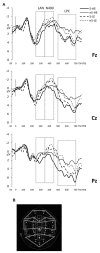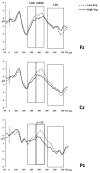Are All Code-Switches Processed Alike? Examining Semantic v. Language Unexpectancy
- PMID: 33013544
- PMCID: PMC7494828
- DOI: 10.3389/fpsyg.2020.02138
Are All Code-Switches Processed Alike? Examining Semantic v. Language Unexpectancy
Abstract
Prior studies using the event-related potential (ERP) technique show that integrating sentential code-switches during online processing leads to a broadly distributed late positivity component (LPC), while processing semantically unexpected continuations instead leads to the emergence of an N400 effect. While the N400 is generally assumed to index lexico-semantic processing, the LPC has two different interpretations. One account suggests that it reflects the processing of an improbable or unexpected event, while an alternative account proposes sentence-level reanalysis. To investigate the relative costs of semantic to language-based unexpectancies (i.e., code-switches), the current study tests 24 Spanish-English bilinguals in an ERP reading study. Semantically constrained Spanish frames either varied in their semantic expectancy (high vs. low expectancy) and/or their language continuation (same-language vs. code-switch) while participants' electrophysiological responses were recorded. The Spanish-to-English switch direction provides a more naturalistic test for integration costs to code-switching as it better approximates the code-switching practices of the target population. Analyses across three time windows show a main effect for semantic expectancy in the N400 time window and a main effect for code-switching in the LPC time window. Additional analyses based on the self-reported code-switching experience of the participants suggest an early positivity linked to less experience with code-switching. The results highlight that not all code-switches lead to similar integration costs and that prior experience with code-switching is an important additional factor that modulates online processing.
Keywords: N400; bilingual (Spanish/English); code-switching; event-related potentials; late positive complex; semantic processing.
Copyright © 2020 Valdés Kroff, Román and Dussias.
Figures




Similar articles
-
The Effect of Code-Switching Experience on the Neural Response Elicited to a Sentential Code Switch.Languages (Basel). 2022 Sep;7(3):178. doi: 10.3390/languages7030178. Epub 2022 Jul 11. Languages (Basel). 2022. PMID: 36188491 Free PMC article.
-
Lexical-semantic processing costs are not inherent to intra-sentential code-switching: The role of switching habits.Neuropsychologia. 2021 Aug 20;159:107922. doi: 10.1016/j.neuropsychologia.2021.107922. Epub 2021 Jun 24. Neuropsychologia. 2021. PMID: 34174298
-
The fox and the cabra: an ERP analysis of reading code switched nouns and verbs in bilingual short stories.Brain Res. 2014 Apr 4;1557:127-40. doi: 10.1016/j.brainres.2014.02.009. Epub 2014 Feb 14. Brain Res. 2014. PMID: 24530431 Free PMC article.
-
Getting real about semantic illusions: rethinking the functional role of the P600 in language comprehension.Brain Res. 2012 Mar 29;1446:127-43. doi: 10.1016/j.brainres.2012.01.055. Epub 2012 Feb 2. Brain Res. 2012. PMID: 22361114 Review.
-
[N400: an electrophysiological measure of semantic processing].Rev Neurol. 2003 Jun 16-30;36(12):1176-80. Rev Neurol. 2003. PMID: 12833239 Review. Spanish.
Cited by
-
The Effect of Code-Switching Experience on the Neural Response Elicited to a Sentential Code Switch.Languages (Basel). 2022 Sep;7(3):178. doi: 10.3390/languages7030178. Epub 2022 Jul 11. Languages (Basel). 2022. PMID: 36188491 Free PMC article.
-
Used to Be a Dime, Now It's a Dollar: Revised Speech Perception in Noise Key Word Predictability Revisited 40 Years On.J Speech Lang Hear Res. 2024 Apr 8;67(4):1229-1242. doi: 10.1044/2024_JSLHR-23-00615. Epub 2024 Apr 2. J Speech Lang Hear Res. 2024. PMID: 38563688 Free PMC article.
-
Different language control mechanisms in comprehension and production: Evidence from paragraph reading.Brain Lang. 2024 Jan;248:105367. doi: 10.1016/j.bandl.2023.105367. Epub 2023 Dec 19. Brain Lang. 2024. PMID: 38113600 Free PMC article.
-
Moving From Bilingual Traits to States: Understanding Cognition and Language Processing Through Moment-to-Moment Variation.Neurobiol Lang (Camb). 2021 Nov 11;2(4):487-512. doi: 10.1162/nol_a_00046. eCollection 2021. Neurobiol Lang (Camb). 2021. PMID: 37214629 Free PMC article. Review.
-
Cross-language priming effects in bilingual novel metaphor processing.Sci Rep. 2025 Aug 22;15(1):30971. doi: 10.1038/s41598-025-16841-5. Sci Rep. 2025. PMID: 40847075 Free PMC article.
References
-
- Beatty-Martínez A. L., Dussias P. E. (2017). Bilingual experience shapes language processing: evidence from codeswitching. J. Mem. Lang. 95, 173–189. 10.1016/j.jml.2017.04.002 - DOI
-
- Beatty-Martínez A. L., Valdés Kroff J. R., Dussias P. E. (2018). From the field to the lab: a converging methods approach to the study of codeswitching. Language 3:19. 10.3390/languages3020019 - DOI
Publication types
LinkOut - more resources
Full Text Sources

